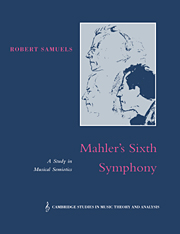Book contents
2 - Motive as sign: an analysis of the Andante
Published online by Cambridge University Press: 17 November 2009
Summary
Like several other of Mahler's symphonic slow movements, the Andante of the Sixth Symphony appears isolated from the rest of the work. Its tonality, melodic profile and mood (for want of a better term) all oppose the content of the other three movements, and in addition exhibit a closure of gesture which encourages the view of the movement as almost a separable Charakterstück. This isolation, which to some extent could be remarked in the Adagietto of the Fifth Symphony or the Nachtmusiken of the Seventh, is the more noticeable because of the high degree of cross-reference and gestural unclosure in the first movement, Scherzo and Finale. There is a clear connection between the Andante and the compositional methods of the Kindertotenlieder and Rückert-Lieder, a comparison which is explicitly betrayed by the occurrence of a cadential figure from the song Nun will die Sonn' so hell aufgeh'n at the end of the opening melody (bar 9). Although this song is not entirely autonomous (the Kindertotenlieder are constructed as a genuine ‘multipiece’), the self-containment of the symphonic song or song-cycle genre is clearly a referent of the symphonic slow movement.
There are, of course, many ways in which the Andante can be accommodated to a narrative of the work as a whole, and indeed even the explicit connections between it and the other movements are more numerous than at first seems the case. The choice of key, a tritone away from the A of the other movements and in the major mode rather than the minor, seems a self-conscious choice of opposition, and hence connection, to the rest of the Symphony.
- Type
- Chapter
- Information
- Mahler's Sixth SymphonyA Study in Musical Semiotics, pp. 18 - 63Publisher: Cambridge University PressPrint publication year: 1995
- 1
- Cited by



